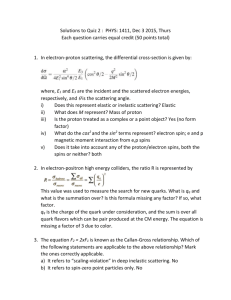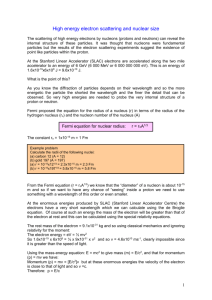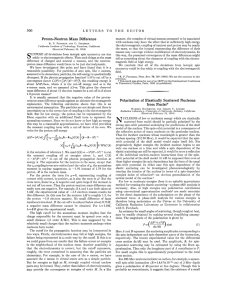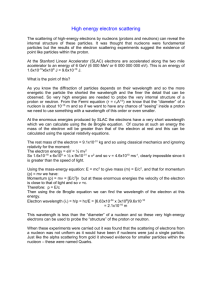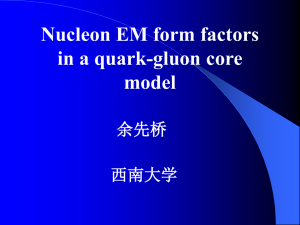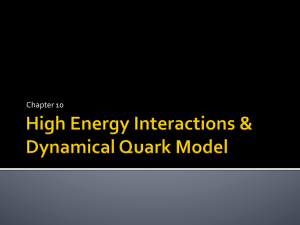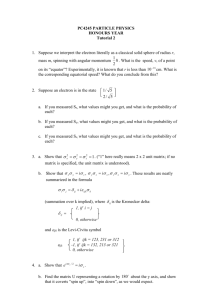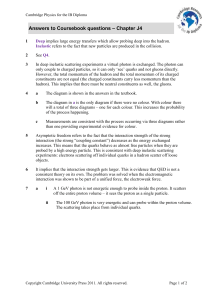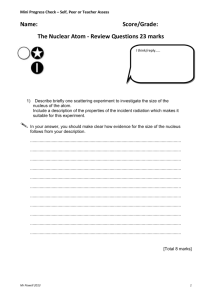PowerPoint
advertisement
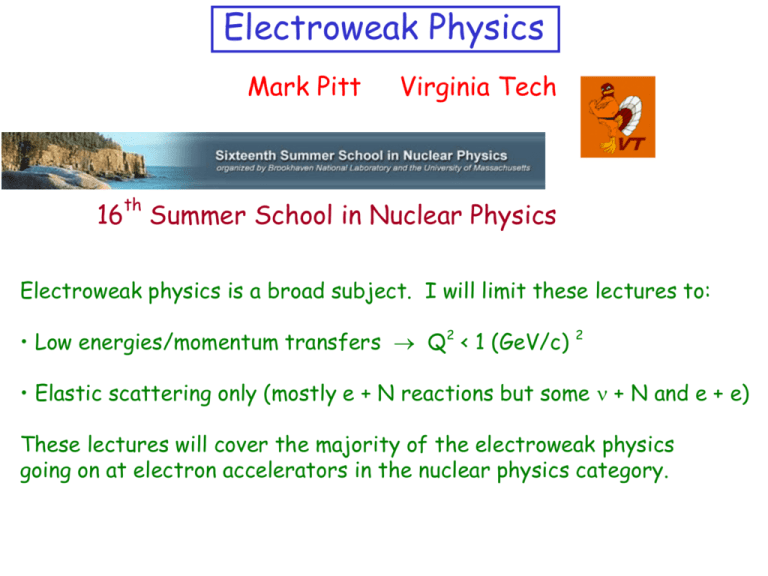
Electroweak Physics Mark Pitt Virginia Tech th 16 Summer School in Nuclear Physics Electroweak physics is a broad subject. I will limit these lectures to: • Low energies/momentum transfers Q2 < 1 (GeV/c) 2 • Elastic scattering only (mostly e + N reactions but some + N and e + e) These lectures will cover the majority of the electroweak physics going on at electron accelerators in the nuclear physics category. Lecture 1 What are we going to cover? e Z N e + N e + N N = nucleon Electromagnetic Form Factors (GEp , GMp , GEn , GMn ) • GEp , GMp ratio • 2 photon physics • improved knowledge of GEn e N e + N e + N N = nucleon Parity-violating electron scattering Neutral Weak Form Factors (GEZ,p , GMZ,p , GEZ,n , GMZ,n , GAe) • Strange vector form factors • Nucleon's anapole moment Low energy Standard Model Tests • Weak charge of the electron • Weak charge of the proton • Weak charge of the neutron We will also cover the experimental techniques unique to the parity-violating electron scattering types of experiments. Some Useful Resource Material on this Topic Good recent review articles: K.S. Kumar and P.A. Souder, Prog. Part. Nucl. Phys. 45, S333 (2000) D.H. Beck and B.R. Holstein, Int. J. Mod. Phys. E10, 1 (2001) D.H. Beck and R.D. McKeown, Ann. Rev. Nucl. Part. Sci. 51, 189 (2001) And two very recent topical workshops (talks posted online at both sites) http://www.krl.caltech.edu/~subZ/meet/index.html http://lpsc.in2p3.fr/congres/pavi2004/ Outline of Lectures 1. Develop the formalism of parity-violating electron scattering with stops for: • electromagnetic form factors • QCD and nucleon "strangeness" 2. Experimental aspects unique to all parity-violating electron scattering experiments 3. Review of experiments devoted to strange form factor measurements (including new results just reported last week) 4. Motivation for low energy Standard Model tests 5. Review of experiments devoted to low energy Standard Model tests Kinematics of Elastic Electron-Nucleon Scattering p' , E' v, q e p,E E - E' q p p' N energy tra nsfer to recoiling nucleon 3 - momentum transfer to recoiling nucleon 2 q - q -Q 2 2 2 Q 2 4 E E ' sin 2 e squared 4 - momentum transfer Lorentz invariant Recall the Dirac Equation and Currents Dirac equation for free electron: (i m) 0 where: 1 0 0 0 0 , 0 0 1 with: 0 time, 1,2,3 space leads to electron four-vector current density: j e where the adjoint is: satisfies the continuity equation: 0 j 0 Bilinear Covariants and Their Symmetry Properties We describe physical processes through interacting currents need to construct most general form of currents consistent with Lorentz invariance Terms of the form (4 4) Pseudoscal ar 5 Vector Axial Vector 5 Tensor Scalar P 1 T 1 C 1 1 1 1 1 1 1 1 1 1 1 1 where 5 i 0 1 2 3 P: parity operator (spatial inversion) T: time reversal C: charge conjugation Note: P (V*V) = +1 P (A*A) = + 1 P (A*V) = -1 1 1 1 Relation Between Cross Sections and Matrix Elements For a process A+B C+D the differential cross section is d d cm 1 pf M 2 64 s pi 2 The physics is all in the matrix element M Electromagnetic and Weak Interactions : Historical View EM: e + p e + p J EM ,e EM , p J e p - p J weak ,e J weak , N e n e M J EM , p elastic scattering e 2 , EM ,e 2 J p p Q e2 2 e e Q V Weak: n e- + p + e x V neutron beta decay Fermi (1932) : contact interaction, form inspired by EM M J weak , N GF J , weak ,e p n GF e e V x V Parity Violation (1956, Lee, Yang; 1957, Wu): required modification to form of current - need axial vector as well as vector to get a parity-violating interaction M J weak , N GF J , weak ,e p 1 5 n GF e 1 5 e (V - A) x (V - A) Note: weak interaction process here is charged current (CC) But Zel'Dovich Suggests - What About Neutral Weak Currents ? The Neutral Current, Zel'Dovich continued Standard Model of Electroweak Interactions (1967) Weinberg-Salam Model (1967): electroweak - unified EM and weak SU(2) x U(1) gauge theory with spontaneous symmetry breaking fermions: Leptons: e-, e -, - , + anti-particles Quarks: u , d s , c b,t + anti-particles gauge bosons: EM: (m = 0) weak: W+,- (mW = 80 GeV/c2) f Z0 (mZ = 91 GeV/c2) W+,f f' electromagnetic interaction: charged fermions participate Z0 f' f charged current weak interaction: all fermions participate Neutral weak currents first observed at CERN in 1973 in reactions like e e f' neutral current weak : all fermions participate Feynman Rules for Calculating M in the Standard Model The fundamental parameter of the Standard Model is the weak mixing angle - W sin e where e and g are the electromag netic and weak couplings W g Feynman rules: e 1 Q2 g 1 Q 2 M W2 2 2 5 1 Q 2 M Z2 +,- W g 2 cos W Z0 - only couples to electromagnetic vector current W, Z - couple to both weak vector and axial-vector currents e2 g2 M EM 2 M weak 2 Q Q M W2 , Z For Q 2 M Z2 M weak g 2Q 2 ~ 2 2 M EM e M W , Z 2 g2 Note : GF 8 M W2 is the Fermi coupling constant c f V c Af 5 Electromagnetic e- p Elastic Scattering From the Feynman rules, the matrix element is: M J EM , p e , EM ,e 2 J J EM , p Q 2 e 2 e e Q 2 e But the proton (unlike the electron) is not a point-like Dirac particle (need to introduce form factors to characterize its structure): 2 i q 2 uN N | J | N u N F1 (Q ) F2 (Q ) 2M N Pauli Dirac Another way to write the form factors is the Sachs definition: GE F1 F2 GM F1 F2 Q2 4M N2 The cross section for e-p elastic scattering is then given as: (Rosenbluth formula) 2 2 d d GE GM 2 2 2 e M 2 G tan M d d Mott N Proton and Neutron EM Form Factors: Measurements GpE (Q2) Q 2 ~ 0 2 GeV 2 GEp (0) q e G p M (Q2) All follow (appear) to follow dipole form: GD Q 2 1 Q2 1 2 0 . 71 ( GeV/ c ) 2 In Breit frame GMp (0) p 2.79 N Fourier transform yields spatial distribution (R) = o exp(-R/Ro) where R o ~ 0.25 fm GnM (Q2) E spatial charge distribution GMn (0) n M spatial magnetization distribution 1.91 N Nucleon Spacelike (q2 < 0) Electromagnetic Form Factors J F1 F2 i q Dirac Pauli 2M N Sachs: GE F1 F2 GM F1 F2 Q2 4M N2 • 1960’s – early 1990’s : GpE , GpM, GnE , GnM measured using Rosenbluth separation in e + p (elastic) and e + d (quasielastic): d d GE2 GM2 2 2 e 2GM tan d d Mott • early 1990’s – present: Polarization observables and ratio techniques used e N e' N ' e N e' N ' d ...(GE2 ...GM2 ) ...Pe PNGE GM ...Pe PN|| GM2 d ( d / d ) unpol A A|| Nucleon Spacelike EM Form Factors, World Data - 1993 GpM/pGD GnM/nGD Relative error ~ 2% ~ 5-10% GpE/GD ~ 10-20% (GnE)2/G2D ~ 50-100% Knowledge of nucleon spacelike EM form factors in 1993: GpE , GpM, GnM follow dipole form GD = (1 + Q2/0.71)-2 at ~20% level GnE ~ 0 (from quasielastic e-d data) p Proton Electromagnetic Form Factor Ratio: G E / G p M Older data: Rosenbluth separation JLab 2000: M. K. Jones, et al. JLab 2002: O. Gayou, et al. using measurements of recoil proton polarization in Hall A with e+p e +p GE Pt E e E e' e tan 2 GMp Pl 2M p Difference in the spatial distribution of charge and magnetization currents in the proton p p Proton EM Form Factor Ratio F 2 / F 1 : pQCD predictions pQCD prediction: As Q2 Fp1 1/Q4 Fp2 1/Q6 Q2 Fp2 /Fp1 constant not being reached yet Ralston, et al. suggested different scaling behavior: Fp2 /Fp1 1/Q when quark orbital angular momentum included Comparison of Polarization Transfer and Rosenbluth Techniques Recent work on Rosenbluth: • reanalyis of old SLAC data (Arrington) • reanalysis of old JLAB data (Christy) • new "Super-Rosenbluth" measurement in Hall A (Segel, Arrington) Conclusion: • No problem with Rosenbluth • No problem with polarization transfer What about radiative corrections? Have 2-photon graphs been underestimated in the past? M. Vanderhaeghen and others say YES. Using the GEp and GMp from polarization transfer and improved calculation of two photon graphs, they can reproduce the Rosenbluth results. Still an active area, more later if time... Neutron Electric Form Factor Data from: beam-target asymmetries recoil polarization in: d (e, e’ n) GnE (Q2) d (e, e’ n) 3 He (e, e’ n) at: Mainz MAMI Jefferson Lab NIKHEF MIT-Bates Neutron Electric Charge Distribution __ (u d) p (u u d) n (u d d) ND3 DNP Polarized Target Apparatus of JLAB E93-026 Microwave Input NMR Signal Out Frequency Refrigerator To Pumps To Pumps LN2 LN2 Liquid Helium Liquid Helium Magnet e– Beam 4-94 Target (inside coil) 1° K NMR Coil B 5T 7656A1 Neutron’s Magnetic Form Factor G n M: Current Status The most precise recent data comes from ratio measurements: (d(e,e’n)) (d(e,e’p)) at NIKHEF/Mainz (Anklin, Kubon, et al.) and ELSA at Bonn (Bruins, et al.) (JLAB 95-001) Large (8-10%) systematic discrepancy between the two data sets : likely due to error in neutron detection efficiency Newest data: JLAB 95-001 (Xu, et al. 2000) 3He(e, e’) in Hall A agrees with NIKHEF/Mainz data at Q2 = 0.1, 0.2 GeV2 more data exists (Q2 = 0.3 - 0.6 GeV2) but requires improved nuclear corrections (relativistic effects need to be included) How can we get the nucleon form factors theoretically? Quantum chromodynamics (QCD): believed to be the correct theory of strong interactions • quarks (3 colors for each) inteacting via exchange of • gluons (8 types) Until recently only stable objects were mesons (2 quark) and baryons (3 quark) proton u u d gluon u u s s valence quarks “non-strange” sea (u, u, d, d) quarks “strange” sea (s, s) quarks So we know the constituents of the proton, we have a quantum field theory for their interaction why can't we solve for its structure? Calculation of Electron’s Magnetic Moment in QED Quantum Electrodynamics (QED): theory of interacting electrons and photons perturbation expansion in ~ 1/137 ((g-2)/2)theory = (115965230 10) x 10-11 ((g-2)/2)experiment = (115965219 1) x 10-11 agreement at 1 part in 108 level Non-perturbative QCD Quantum Chromodynamics (QCD): theory of interacting quarks and gluons QCD(running of s) For quarks inside the nucleon, typical momenta q ~ 0.3 GeV/c s ~ 1 cannot solve perturbatively (unlike QED where ~ 1/137) s Eventually, lattice QCD should provide the solution; In meantime we can measured welldefined nucleon properties that will serve as benchmarks for lattice QCD like the sea of strange quarks, for example! Do Strange Quarks Contribute to Nucleon Properties? Deep inelastic scattering, contributions of constituents (partons) to total momentum of proton: valence quarks: uV 21% dV 9% sea quarks: (u+u) : 7% (c+c): 3% gluons: 46% (d+d): 8% (b+b): 1% (s+s): 5% + s c + X + + + Proton spin: measured in polarized deep inelastic scattering 1 1 u d s Lq J g 2 2 u d s 0.30 0.10 s 0.1 0.03 “Proton spin crisis” What role do strange quarks play in nucleon properties? proton u u d u gluon u s 1 s x(s s)dx Momentum: valence quarks “non-strange” sea (u, u, d, d) quarks “strange” sea (s, s) quarks ~ 4% (DIS) 0 Spin: N | s s | N ~ 10% (polarized DIS) Mass: N | ss | N ~ 30% (N - term) Charge and current: N | s s | N ?? GEs GMs Main goal of these experiments : To determine the contributions of the strange quark sea (s s) to the electromagnetic properties of the nucleon ("strange form factors"). The complete nucleon landscape - unified description Elastic scattering: transverse quark distribution in coordinate space Deep exclusive scattering (DES): Generalized parton dist. (GPD): fully-correlated quark distribution in coordinate and momentum space Electric and magnetic form factors well - measured GE GM for p, n BUT quark flavor decomposit ion of these form factors is not yet known G uE ,M GEd , M GEs , M Deep inelastic scattering (DIS): Measured nucleon momentum fractions (Q 2 2 GeV 2 ) : u u ~ 37% d d ~ 20% s s ~ 4% glue ~ 39% longitudinal quark distribution in momentum space The question to be answered by this research: How does the sea of strange quarks (ss pairs) inside the proton (or neutron) contribute to its electromagnetic properties: p p n n G E , G M, G E , G M ? Let's measure the strange form factors s s G E, G M directly and find out. JLAB “contracted” to understand nuclei Nucleon form factors measured in elastic e-N scattering Nucleon form factors • well defined experimental observables • provide an important benchmark for testing non-perturbative QCD structure of the nucleon e N|J |N e N | J | N Z N GE , GM electromagnetic form factors N Z Z E Z M G ,G neutral weak form factors • Measured precision of EM form factors in 0.1 - 1 GeV2 Q2 range ~ 2 - 4% • Projected precision of NW form factors in 0.1 - 1 GeV2 Q2 range ~ 10% from the current generation of experiments (for magnetic) where the nucleon wa vefunction is : | N | uud | uudg | uudss | uuduu ... How to Measure the Neutral weak form factors 2 Ne e N 2 Z + e he N Z e N 2 Z e N e N (elastic scattering ) R L A R L e p e p 2 - G FQ 2 5 6 form factors 10 10 4 e N Derive the Parity-Violating Asymmetry (hand-waving) J EM ,e Qe e e QeVEM ,e J NC ,e 1 4 sin 2 W e e e 5 e gVe VNC ,e g Ae ANC ,e J EM , N VEM , N J NC , N VNC , N ANC , N 1 M EM ~ 2 QeVEM ,eVEM , N Q G M NC ~ gVe VNC ,eVNC , N g Ae ANC ,eVNC , N gVe VNC ,e ANC , N g Ae ANC ,e ANC , N 2 2 M M EM M NC Cross section proportion al to : * M M EM 2 Re( M EM M NC ) M NC 2 L A R R L 2 2 * PV 2 Re( M EM M NC ) M EM ... 2 EM ,e EM , N e NC ,e NC , N g A A V QeVEM ,eVEM , N gVe VNC ,e ANC , N GF Q 2 QeV V 2 4 2 QeVEM ,eVEM , N Derive the Parity-Violating Asymmetry (hand-waving), cont. L A R R L EM ,e EM , N e NC ,e NC , N g A A V QeVEM ,eVEM , N gVe VNC ,e ANC , N GF Q 2 QeV V 2 4 2 QeVEM ,eVEM , N R L GF Q 2 AE AM AA A R L 4 2 2 unpol AE ( ) GEZ (Q 2 )GE (Q 2 ) AM (Q 2 ) GMZ (Q 2 )GM (Q 2 ) AA (1 4 sin 2 W ) G Ae (Q 2 )GM (Q 2 ) = Q2/4M2 = [1+2(1+)tan2(/2)]-1 Now how do the neutral weak form factors GEZ and GMZ give us information about the strange form factors? First some notation Recall, we defined the nucleon Dirac and Pauli form factors through : i q N | J | N u N F1 (Q 2 ) F2 (Q 2 ) 2M N uN Define the nucleon form factors associated with a given quark current q as : q i q N | q q | N u N F1 F2q 2M N uN The Sachs form factors are then : GEq F1q F2q GMq F1q F2q Neutral weak form factors strange form factors STANDARD MODEL COUPLINGS e q 1 u +2/3 1 8/3 sin2W 1 d s 1/3 1 + 4/3 sin2W 1/3 1 + 4/3 sin2W +1 +1 qZ 1 + 4 sin2W J Qi qi qi ELECTROWEAK CURRENTS aZ +1 J Z QiZ qi qi i i 2 u, p 1 d , p 1 s, p ,p Flavor decomposition of nucleon E/M p | J | p : GE , M GE , M GE , M GE , M 3 3 3 form factors: 2 1 1 n | J | n : GE ,,nM GEu ,,nM GEd ,,Mn GEs ,,nM 3 3 3 4 4 8 p | J Z | p : GEZ,,Mp 1 sin 2 W GEu ,, Mp 1 sin 2 W GEd ,,Mp 1 sin 2 W GEs ,,pM 3 3 3 Invoke proton/neutron charge symmetry G ,p ,n Z,p , G , G E ,M E ,M E ,M G 3 equations, 3 unknowns u d s , G , G E ,M E ,M E ,M Validity of charge symmetry breaking assumption u d GEu ,, Mp GEd ,,Mn GEd ,,Mp GEu ,,nM GEs ,,pM GEs ,,nM Size of charge symmetry breaking effects in some n,p observables: • n - p mass difference (mn - mp)/mn ~ 0.14% • polarized elastic scattering n + p, p+n A = An - Ap = (33 ± 6) x 10-4 Vigdor et al, PRC 46, 410 (1992) • Forward backward asymmetry n + p d + 0 Opper et al., nucl-ex 0306027 (2003) Afb ~ (17 ± 10)x 10-4 For vector form factors theoretical CSB estimates indicate < 1% violations (unobservable with currently anticipated uncertainties) (Miller PRC 57, 1492 (1998) Lewis and Mobed, PRD 59, 073002(1999) Parity Violating Electron Scattering Probe of Neutral Weak Form Factors polarized electrons, unpolarized target e R L GF Q AE AM AA A R L 4 2 2 unpol 2 AE ( ) GEZ (Q 2 )GE (Q 2 ) AM (Q 2 ) GMZ (Q 2 )GM (Q 2 ) AA (1 4 sin 2 W ) GAe (Q 2 )GM (Q 2 ) p e GEs GMs G Ae At a given Q2 decomposition of GsE, GsM, GeA Requires 3 measurements for full decomposition: Forward angle e + p (elastic) Backward angle e + p (elastic) Backward angle e + d (quasi-elastic) p 2 Strange electric and magnetic form factors, + axial form factor
